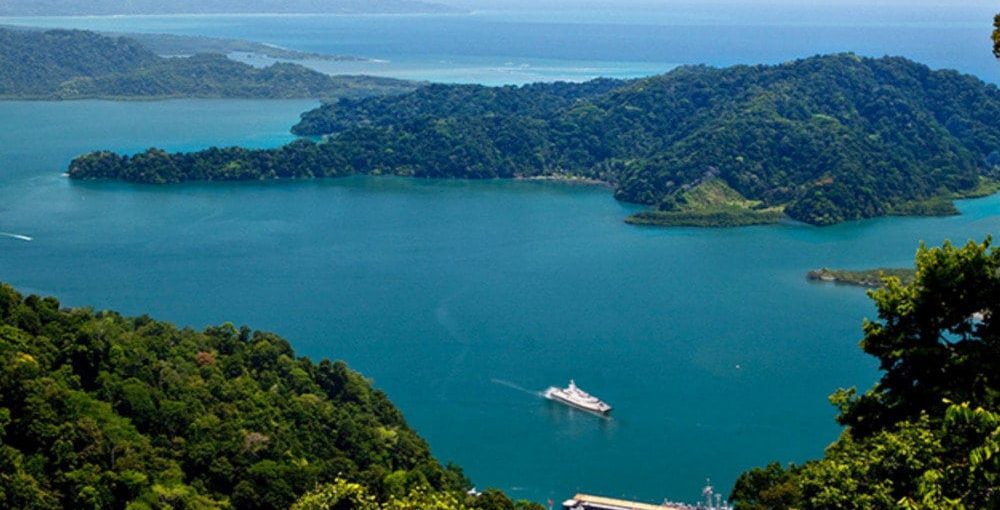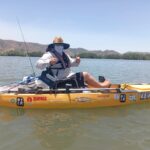Golfito’s Blue Gold
The offshore seamounts produce outstanding action in this corner of Central America
Published for Marlin Magazine
Thumper is like a grand old Southern dame: aging gracefully, showing a few wrinkles here and there, but still able to dance with the best of ’em. The 60-foot Mikelson sashays out toward the deep seamounts off Costa Rica’s southern Pacific coast, the boat’s classic wood interior creaking comfortably as she shoulders aside the wind-whipped frenzy of swells. Darkness comes quickly in Central America—after an all-night chug at 7 knots, we’ll be ready to fish at sunrise.
Thumper’s owner, Harry Glah, is a throwback. He graduated from Pennsylvania’s Villanova University in 1967, enlisted in the US Army and spent some time in Southeast Asia, along with many other young Americans of his generation. After the service, Glah went into business with an Australian chap he met in Laos, sold the company a few years later, and moved to New York City. He hit it big on Wall Street and spent a successful career working for Morgan Stanley and the Royal Bank of Canada, but kept the hippie ponytail he’d sported for years after the military. Still has it today, in fact—happily retired and fishing his ass off at 74.
The port town of Golfito, Costa Rica, Thumper’s home port for over two decades, seems like a perfect fit for the man and the boat—they are both happy there. “After owning a couple of smaller boats, my first offshore rig was a 39 Topaz Royale,” Glah says. “At the time, I was inspired by Tred Barta, so we used to chase the bigeye tuna from the canyons off New York to Ocean City, Maryland—we won the Ocean City Tuna Tournament in 2002 with a 220-pound bigeye. After a few years, with the kid’s college paid for, I wanted something a little bigger. My research led me to Mikelson Yachts in San Diego. The company built a 60-footer it described as having the interior of a 50 and the exterior of a 70, thanks to the wide walkarounds on the deck that offered great access to the bow, with a huge cockpit and mezzanine seating aft.”
In 2006, he got a phone call from Mikelson owner Bob Peterson saying that he had a used 60 for sale, so Glah and his wife at the time, since deceased, bought a cargo van from a used-car lot, piled all their boat and fishing gear in it, drove cross-country to San Diego, bought the boat and began a leisurely seven-month journey back to Sunset Marina. “We started fishing out of Ocean City, but it just wasn’t working,” Glah says. “When we had time to fish, the weather was less than ideal. I kept thinking back to all those great ports we had visited in the Pacific on the way back from California, and my mind kept coming back to the great times and awesome fishing we had in Golfito.”
This quaint fishing village on the Pacific side of southern Costa Rica remains much the same as it has for the past 100 years, yet the fishing remains as good—perhaps even better—than it ever has been in the past. The town lies on a narrow ribbon of land along the coast, with a lush, verdant rainforest and low mountains just inland. There’s a small residential area near the port; Golfito town and the marinas are a little farther south. On the northern side is a duty-free zone, known as the deposito, and a small airstrip that’s served by regional carriers such as Sansa, as well as private aircraft. Once a major banana-growing region—and the primary reason for its development as a port city—that industry hit on hard times when the United Fruit Company closed in 1985. Palm oil replaced banana crops, with huge palm plantations springing up along the Costa Rican countryside.
By the early 2000s, sport fishing had taken center stage as an economic driver in Golfito. Within the huge protected bay right out front—Golfo Dulce, the remnants of a supervolcano over 50 miles in circumference that imploded a millennium ago—anglers could catch just about anything, from roosterfish and cubera snapper to big trevally and African pompano, as well as a host of other species. The offshore waters just beyond offered consistent fishing for marlin, sails, tuna, dorado and more. Fishing lodges such as Roy’s Zancudo and Golfito Sailfish Rancho were posting some amazing catches and numerous IGFA world records, so a small-but-sturdy charter fleet emerged in Golfito. One of those boats belonged to Capt. Tommy Lynskey, a Miamian who ran a 51-foot Whiticar out of Fishhook Marina. Lynskey had fished with Glah on one occasion aboard Thumper down near the Panamanian border; that trip left an indelible impression on both men. In 2007, Thumper returned to her new home in Golfito, where she remains today.
Although it seems much longer, it was only around eight years ago that the offshore seamount fishery in southern Costa Rica started producing unbelievable numbers of blue marlin. It’s due to several factors, one of which is plate tectonics. Southern Costa Rica is one of the unique places on Earth where three different tectonic plates intersect. The entire area is rife with volcanic activity, with seamounts rising from the thousand-fathom bottom at the Panama border to the west along the coast of Costa Rica for more than 50 miles and over 100 miles south, out into the distant Pacific Ocean. These undersea mountain ranges are positioned alongside strategic blue marlin migratory routes, and they also hold vast shoals of bonito and yellowfin tuna. As more recreational sport-fishing boats ventured into the deep on multiday trips, often spending several nights on the sea anchor offshore, one thing became clear: The entire area was absolutely loaded with blue marlin. See 400 blues in the spread? No problem—Lynskey did that on Thumper over a hot 10-day stretch in August 2019. Catch a thousand blues in a season? Always an impressive accomplishment but not that hard for the right program. Capt. Pete Rae did it during the 2014-2015 season on Sea Spud, fishing out of Fishhook Marina. As Lynskey says, it’s one giant fishbowl.
After flying into San Jose and meeting up with fellow anglers Jim Czaban, a biotechnology regulatory attorney, and Chris Davis, a partner in a private-equity firm, along with photographer Jimmy Olson, we headed down to Golfito, arriving just after dark. Lynskey and Glah were ready to roll, with the diesels idling and a dinner of local jumbo shrimp already on the table. As we pushed off into the darkness to begin an all-night chug, the wind was already whistling through the outriggers. It’s going to be right sporty out there, I thought. Usually seamount conditions are reasonably calm although often rainy, as was the case with our trip in fall 2019, but a tropical wave had kicked up the wind and seas just in time for our departure. Not to worry, though. Thumper handled the conditions admirably, and we were ready to fish in the hazy bronze light of pre-dawn.
During the early hours upon our arrival, Lynskey had spent some time driving around the various peaks and valleys of the Papa Bank in an effort to locate bait, which, along with current, is a key factor for success. Our duo of well-trained Tico mates were already bait-fishing as we emerged from the salon, keeping just the smaller bonito and yellowfin tuna and releasing anything over about 15 inches or so—although we did keep a few of the larger football tuna for sashimi. “I like the smaller ones because these fish can just inhale them, without having to worry about one getting fouled up on the bite,” Lynskey says.
The spread itself was built for simplicity: a pair of Flippy Floppy teasers paired with Moldcraft Wide Ranges controlled by Lynskey on the bridge; a second pair of teasers—Pakula Sprockets—from the cockpit on the short riggers; and a set of Poseidon lures from the long riggers. The plan was to pitch-bait our fish on the teasers, with the lures giving us a last-ditch shot at a missed or uninterested blue as it departed the spread. On the pitch, we had a pair of Penn 50Ws, with a small tuna or bonito matched to a 10/0 circle hook on one side and a horse ballyhoo with a small Squidnation chugger on the other. There is more than enough room to move because there is no fighting chair or rocket launcher—this is stand-up fishing at its best.
Within minutes of setting the full spread, the first blue appeared for Davis, who pitched a small tuna from his position on the right corner. I was ready to back him up on the left side when the blue faded into the white water for a few tense moments, then reappeared on the left short teaser. Lynskey expertly teased the fish in; a quick drop-back and the 200-pound fish inhaled my ballyhoo nearly at the exhaust pipe. After some amazing aerial acrobatics, we scored our first release of the trip a few minutes later, just as Glah emerged from the salon announcing that breakfast was ready. If there’s a better wake-up call than a pre-dawn blue marlin teaser bite, I haven’t found it yet. The action continued until lunchtime, when the bait seemed to dissipate into the depths—we dodged a few rain showers and had a few more bites in the afternoon, then it was time to deploy the sea anchor and call it a day.
After a second full day on the Papa Bank, we had raised a bunch of blue marlin—all in the 150- to 250-pound class—and had released 12, plus a bonus sailfish. Two days of fighting not only blue marlin but also the 6-to-9-foot whitecapping seas was taking its toll, so that evening we elected to make a down-sea jog some 70 miles toward Punta Burica on the Panamanian border for a shot at a black marlin.
Once we arrived, the sea conditions had changed dramatically thanks to the passage of the tropical wave; calm seas at dawn were a welcome change as Thumper easily surfed down-sea. With the mountains of western Panama in sight, we put out the spread and started to work the area. The fishing off Burica is unique because the dominant feature—a giant dormant undersea volcano that rises to within 500 feet of the surface in 500 fathoms of water—is just 4 miles off the beach. Unfortunately, the rains of October had brought significantly dirty water to the area, along with tons of floating trees and other debris washing offshore. According to Lynskey, the blacks will tolerate green water, especially if there is an abundance of bait, but the conditions didn’t look good. Instead, he switched gears and turned to the radar. Within an hour, we were up and running toward an enormous flock of birds just over the horizon. Below them were pods of Pacific white-sided dolphins, along with some nice yellowfin tuna crashing through bait pods on the surface—an incredible sight to witness anywhere in the world. The mates had already swapped circle hooks for cedar plugs and small skirted lures, and within minutes, we’re all solidly hooked up on tuna around 50 pounds or so. Glah pitched a live blue runner into the melee and came tight to a much larger yellowfin, which he fought for about 20 minutes before the 60-pound-test fluorocarbon leader finally frayed. All this before lunchtime. After a couple of hours of nonstop activity, dodging the ever-present rain showers, we left them biting.
As we went back on the troll uphill toward home, we passed near one of Lynskey’s favorite bottomfishing spots: another dormant undersea volcano in 550 feet of water. Once again, the boys in the pit had us ready to rock ’n’ roll with multihook rigs tipped with bonito strips. After one drift to get set up, we caught some nice snowy grouper—often two at a time—on each drop, topping off the fish boxes before continuing on our way.
Arriving back at the mouth of the Golfo Dulce, we still had a few hours of daylight to burn, so we elected to slow-troll the remaining blue runners in the livewell, while also casting topwater chuggers on heavy spinning rods in hopes of enticing a jumbo roosterfish or big cubera from around the rocky islets near the entrance at Manapalo. A higher-than-normal tide had the inshore fish off the feed though, so we decided to call it a day. We returned to our slip at Fishhook Marina just as the sun set, a fiery orange splash in the west.
While most of the attention in Costa Rica is rightfully focused on the more modern destinations, there is something to be said for fishing the old-school way. That’s what you find in Golfito. It’s the real deal, just as it has been for previous decades, and hopefully will be for many years into the future.
Most visitors will arrive by air to San Jose, the capital of Costa Rica. It’s a little over 100 miles by road to Golfito, and it’s a scenic trip of about five hours or so, depending on traffic. The Golfito Airport (GLF) is in a narrow valley running inland from the bay, with mountains on both sides of the runway and high terrain immediately off the northwestern end; approaches and departures are right over the bay. It’s exciting, but keep in mind that bad weather frequently causes flight cancellations, especially in the rainy season—morning flights can usually get in just fine, but afternoon flights back to San Jose are often delayed or canceled. For that reason, our group chose to take the airport transfer van back to San Jose at the conclusion of our trip rather than risk missing our flights home.
One of several small marinas in Golfito, Fishhook Marina has a charming bar and restaurant. At the conclusion of our trip, we had a terrific dinner of our fresh grouper and tuna prepared several different ways, washing it all down with some cold Imperial beer.
There are plenty of other attractions in the area. Corcovado National Park is on the Osa Peninsula at Puerto Jimenez, across the bay from Golfito. Created in 1975 to protect the area from illegal gold mining and timber operations, the 104,000-acre park has several hiking trails, 13 major ecosystems and more than 20 miles of shoreline. It’s also home to Costa Rica’s largest population of scarlet macaws. For surfers, the legendary break at Pavones is not to be missed. When it’s firing on a southwest swell, it’s among the longest left breaks in the world.
More Sport Fishing Articles
Costa Rica Fishing – A guide to having a good trip
Do I need a Fishing License in Costa Rica?
You May Also Like
[post-carousel-pro id=”5407″]
Join Our Mailing List
[yikes-mailchimp form=”1″]


























